BB208: Analysis of Reward Systems, Employee Discipline, and Retention
VerifiedAdded on 2022/09/25
|7
|1432
|16
Report
AI Summary
This report analyzes the effectiveness of reward systems and employee discipline within organizations, addressing issues of high employee turnover and the importance of fairness. Part A proposes three strategies to improve reward systems: performance-based pay, pay mix compensation policies, and cafeteria systems. These strategies aim to enhance employee motivation and retention by aligning rewards with performance and individual needs, fostering a sense of procedural justice and outcome fairness. Part B focuses on disciplinary actions, suggesting that managing job satisfaction, paying attention to behavioral variables, and implementing progressive discipline can improve employee behavior and promote a positive work environment. The report emphasizes the role of fairness in disciplinary procedures, suggesting that consistent and transparent practices are crucial for maintaining employee trust and commitment. The report offers valuable insights into how organizations can create more effective and equitable management practices.
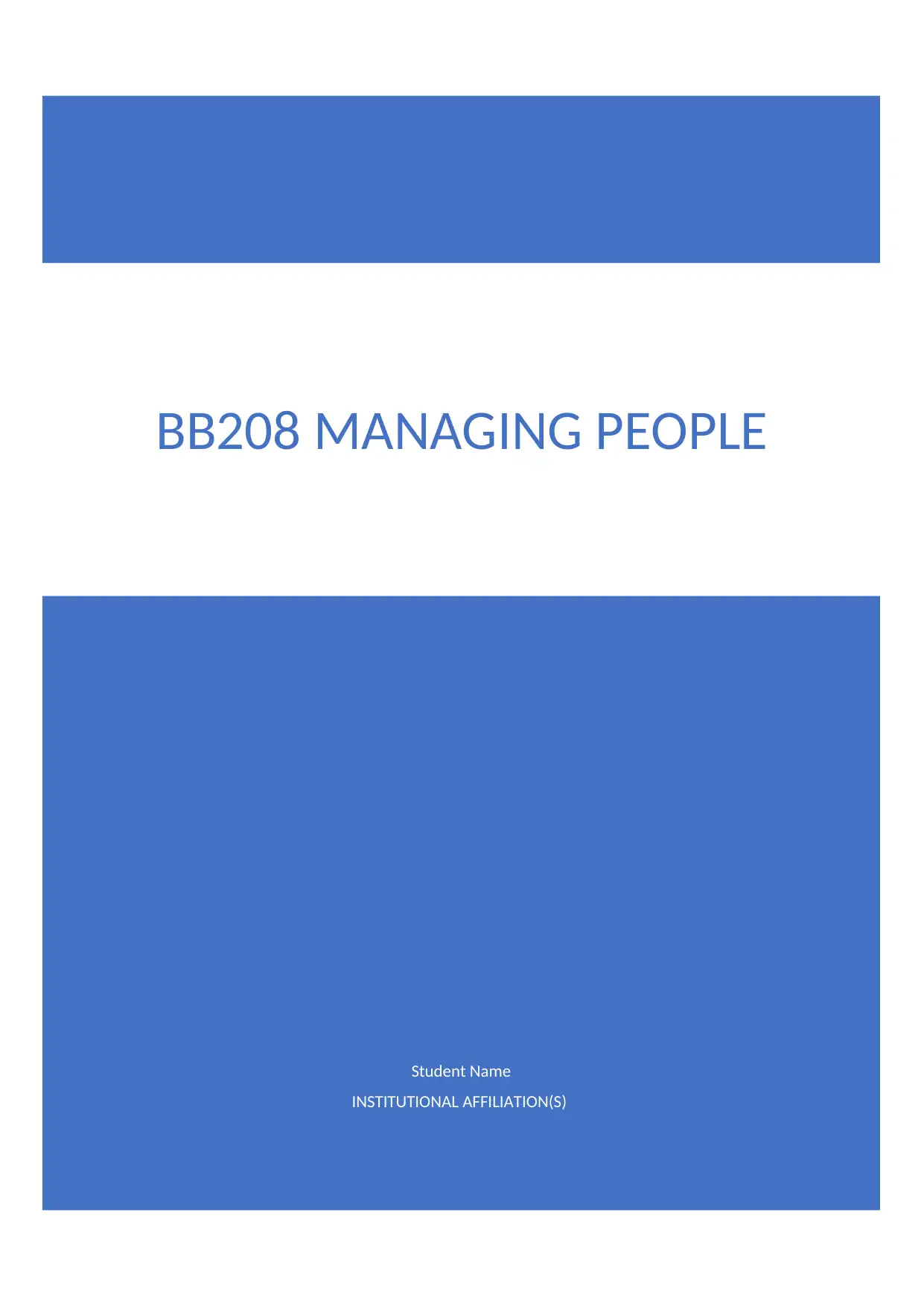
Student Name
INSTITUTIONAL AFFILIATION(S)
BB208 MANAGING PEOPLE
INSTITUTIONAL AFFILIATION(S)
BB208 MANAGING PEOPLE
Paraphrase This Document
Need a fresh take? Get an instant paraphrase of this document with our AI Paraphraser
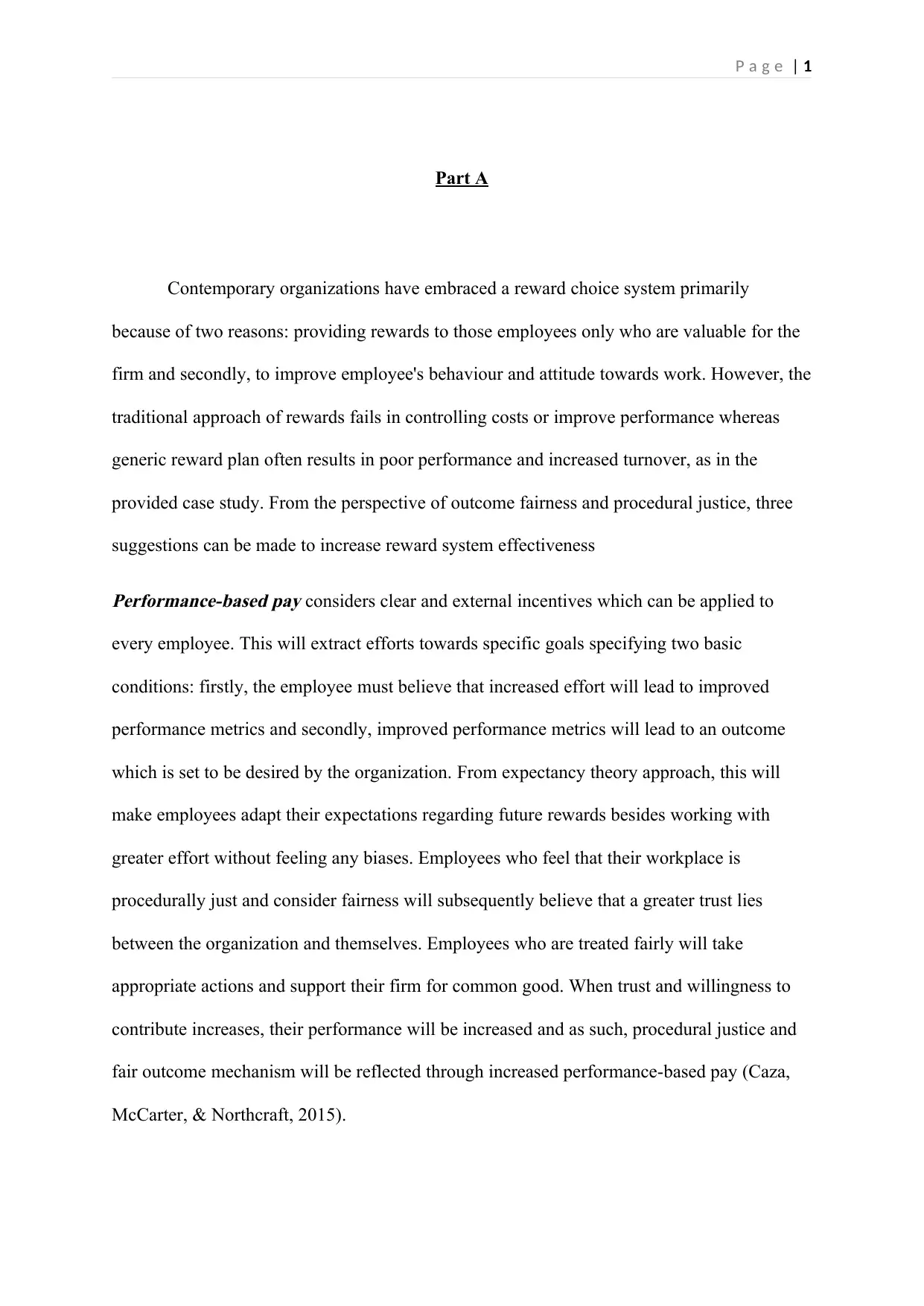
P a g e | 1
Part A
Contemporary organizations have embraced a reward choice system primarily
because of two reasons: providing rewards to those employees only who are valuable for the
firm and secondly, to improve employee's behaviour and attitude towards work. However, the
traditional approach of rewards fails in controlling costs or improve performance whereas
generic reward plan often results in poor performance and increased turnover, as in the
provided case study. From the perspective of outcome fairness and procedural justice, three
suggestions can be made to increase reward system effectiveness
Performance-based pay considers clear and external incentives which can be applied to
every employee. This will extract efforts towards specific goals specifying two basic
conditions: firstly, the employee must believe that increased effort will lead to improved
performance metrics and secondly, improved performance metrics will lead to an outcome
which is set to be desired by the organization. From expectancy theory approach, this will
make employees adapt their expectations regarding future rewards besides working with
greater effort without feeling any biases. Employees who feel that their workplace is
procedurally just and consider fairness will subsequently believe that a greater trust lies
between the organization and themselves. Employees who are treated fairly will take
appropriate actions and support their firm for common good. When trust and willingness to
contribute increases, their performance will be increased and as such, procedural justice and
fair outcome mechanism will be reflected through increased performance-based pay (Caza,
McCarter, & Northcraft, 2015).
Part A
Contemporary organizations have embraced a reward choice system primarily
because of two reasons: providing rewards to those employees only who are valuable for the
firm and secondly, to improve employee's behaviour and attitude towards work. However, the
traditional approach of rewards fails in controlling costs or improve performance whereas
generic reward plan often results in poor performance and increased turnover, as in the
provided case study. From the perspective of outcome fairness and procedural justice, three
suggestions can be made to increase reward system effectiveness
Performance-based pay considers clear and external incentives which can be applied to
every employee. This will extract efforts towards specific goals specifying two basic
conditions: firstly, the employee must believe that increased effort will lead to improved
performance metrics and secondly, improved performance metrics will lead to an outcome
which is set to be desired by the organization. From expectancy theory approach, this will
make employees adapt their expectations regarding future rewards besides working with
greater effort without feeling any biases. Employees who feel that their workplace is
procedurally just and consider fairness will subsequently believe that a greater trust lies
between the organization and themselves. Employees who are treated fairly will take
appropriate actions and support their firm for common good. When trust and willingness to
contribute increases, their performance will be increased and as such, procedural justice and
fair outcome mechanism will be reflected through increased performance-based pay (Caza,
McCarter, & Northcraft, 2015).
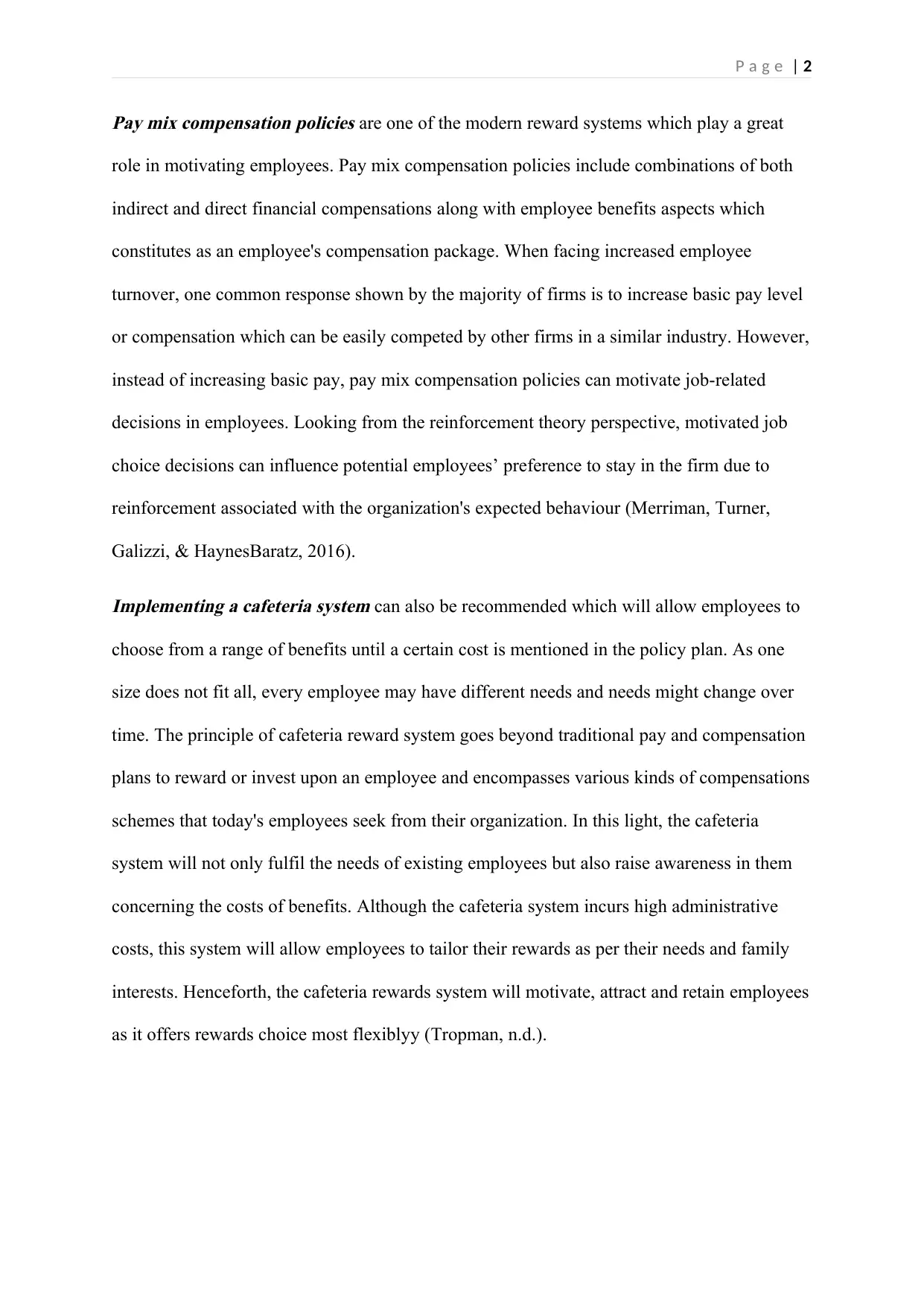
P a g e | 2
Pay mix compensation policies are one of the modern reward systems which play a great
role in motivating employees. Pay mix compensation policies include combinations of both
indirect and direct financial compensations along with employee benefits aspects which
constitutes as an employee's compensation package. When facing increased employee
turnover, one common response shown by the majority of firms is to increase basic pay level
or compensation which can be easily competed by other firms in a similar industry. However,
instead of increasing basic pay, pay mix compensation policies can motivate job-related
decisions in employees. Looking from the reinforcement theory perspective, motivated job
choice decisions can influence potential employees’ preference to stay in the firm due to
reinforcement associated with the organization's expected behaviour (Merriman, Turner,
Galizzi, & HaynesBaratz, 2016).
Implementing a cafeteria system can also be recommended which will allow employees to
choose from a range of benefits until a certain cost is mentioned in the policy plan. As one
size does not fit all, every employee may have different needs and needs might change over
time. The principle of cafeteria reward system goes beyond traditional pay and compensation
plans to reward or invest upon an employee and encompasses various kinds of compensations
schemes that today's employees seek from their organization. In this light, the cafeteria
system will not only fulfil the needs of existing employees but also raise awareness in them
concerning the costs of benefits. Although the cafeteria system incurs high administrative
costs, this system will allow employees to tailor their rewards as per their needs and family
interests. Henceforth, the cafeteria rewards system will motivate, attract and retain employees
as it offers rewards choice most flexiblyy (Tropman, n.d.).
Pay mix compensation policies are one of the modern reward systems which play a great
role in motivating employees. Pay mix compensation policies include combinations of both
indirect and direct financial compensations along with employee benefits aspects which
constitutes as an employee's compensation package. When facing increased employee
turnover, one common response shown by the majority of firms is to increase basic pay level
or compensation which can be easily competed by other firms in a similar industry. However,
instead of increasing basic pay, pay mix compensation policies can motivate job-related
decisions in employees. Looking from the reinforcement theory perspective, motivated job
choice decisions can influence potential employees’ preference to stay in the firm due to
reinforcement associated with the organization's expected behaviour (Merriman, Turner,
Galizzi, & HaynesBaratz, 2016).
Implementing a cafeteria system can also be recommended which will allow employees to
choose from a range of benefits until a certain cost is mentioned in the policy plan. As one
size does not fit all, every employee may have different needs and needs might change over
time. The principle of cafeteria reward system goes beyond traditional pay and compensation
plans to reward or invest upon an employee and encompasses various kinds of compensations
schemes that today's employees seek from their organization. In this light, the cafeteria
system will not only fulfil the needs of existing employees but also raise awareness in them
concerning the costs of benefits. Although the cafeteria system incurs high administrative
costs, this system will allow employees to tailor their rewards as per their needs and family
interests. Henceforth, the cafeteria rewards system will motivate, attract and retain employees
as it offers rewards choice most flexiblyy (Tropman, n.d.).
⊘ This is a preview!⊘
Do you want full access?
Subscribe today to unlock all pages.

Trusted by 1+ million students worldwide
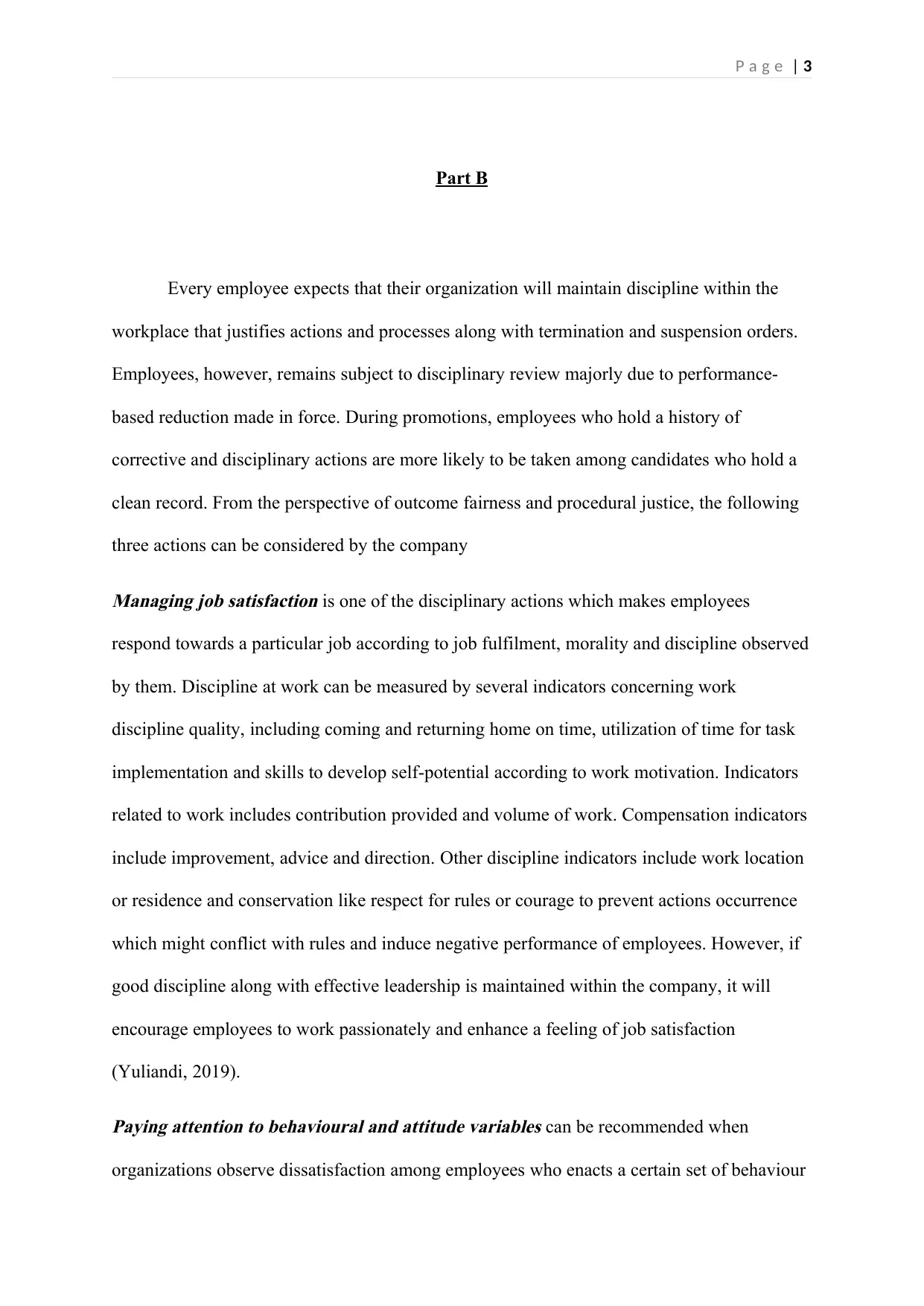
P a g e | 3
Part B
Every employee expects that their organization will maintain discipline within the
workplace that justifies actions and processes along with termination and suspension orders.
Employees, however, remains subject to disciplinary review majorly due to performance-
based reduction made in force. During promotions, employees who hold a history of
corrective and disciplinary actions are more likely to be taken among candidates who hold a
clean record. From the perspective of outcome fairness and procedural justice, the following
three actions can be considered by the company
Managing job satisfaction is one of the disciplinary actions which makes employees
respond towards a particular job according to job fulfilment, morality and discipline observed
by them. Discipline at work can be measured by several indicators concerning work
discipline quality, including coming and returning home on time, utilization of time for task
implementation and skills to develop self-potential according to work motivation. Indicators
related to work includes contribution provided and volume of work. Compensation indicators
include improvement, advice and direction. Other discipline indicators include work location
or residence and conservation like respect for rules or courage to prevent actions occurrence
which might conflict with rules and induce negative performance of employees. However, if
good discipline along with effective leadership is maintained within the company, it will
encourage employees to work passionately and enhance a feeling of job satisfaction
(Yuliandi, 2019).
Paying attention to behavioural and attitude variables can be recommended when
organizations observe dissatisfaction among employees who enacts a certain set of behaviour
Part B
Every employee expects that their organization will maintain discipline within the
workplace that justifies actions and processes along with termination and suspension orders.
Employees, however, remains subject to disciplinary review majorly due to performance-
based reduction made in force. During promotions, employees who hold a history of
corrective and disciplinary actions are more likely to be taken among candidates who hold a
clean record. From the perspective of outcome fairness and procedural justice, the following
three actions can be considered by the company
Managing job satisfaction is one of the disciplinary actions which makes employees
respond towards a particular job according to job fulfilment, morality and discipline observed
by them. Discipline at work can be measured by several indicators concerning work
discipline quality, including coming and returning home on time, utilization of time for task
implementation and skills to develop self-potential according to work motivation. Indicators
related to work includes contribution provided and volume of work. Compensation indicators
include improvement, advice and direction. Other discipline indicators include work location
or residence and conservation like respect for rules or courage to prevent actions occurrence
which might conflict with rules and induce negative performance of employees. However, if
good discipline along with effective leadership is maintained within the company, it will
encourage employees to work passionately and enhance a feeling of job satisfaction
(Yuliandi, 2019).
Paying attention to behavioural and attitude variables can be recommended when
organizations observe dissatisfaction among employees who enacts a certain set of behaviour
Paraphrase This Document
Need a fresh take? Get an instant paraphrase of this document with our AI Paraphraser
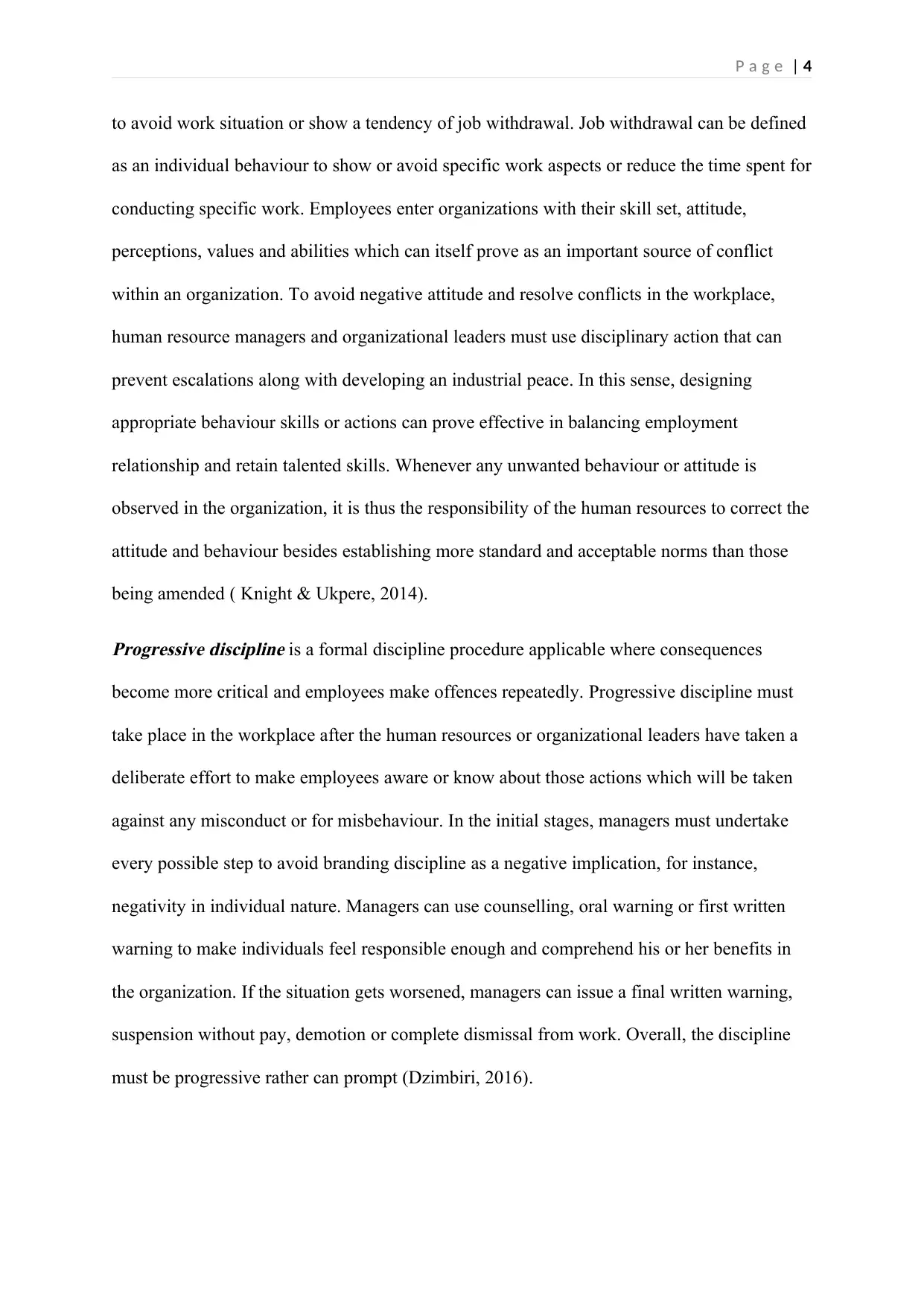
P a g e | 4
to avoid work situation or show a tendency of job withdrawal. Job withdrawal can be defined
as an individual behaviour to show or avoid specific work aspects or reduce the time spent for
conducting specific work. Employees enter organizations with their skill set, attitude,
perceptions, values and abilities which can itself prove as an important source of conflict
within an organization. To avoid negative attitude and resolve conflicts in the workplace,
human resource managers and organizational leaders must use disciplinary action that can
prevent escalations along with developing an industrial peace. In this sense, designing
appropriate behaviour skills or actions can prove effective in balancing employment
relationship and retain talented skills. Whenever any unwanted behaviour or attitude is
observed in the organization, it is thus the responsibility of the human resources to correct the
attitude and behaviour besides establishing more standard and acceptable norms than those
being amended ( Knight & Ukpere, 2014).
Progressive discipline is a formal discipline procedure applicable where consequences
become more critical and employees make offences repeatedly. Progressive discipline must
take place in the workplace after the human resources or organizational leaders have taken a
deliberate effort to make employees aware or know about those actions which will be taken
against any misconduct or for misbehaviour. In the initial stages, managers must undertake
every possible step to avoid branding discipline as a negative implication, for instance,
negativity in individual nature. Managers can use counselling, oral warning or first written
warning to make individuals feel responsible enough and comprehend his or her benefits in
the organization. If the situation gets worsened, managers can issue a final written warning,
suspension without pay, demotion or complete dismissal from work. Overall, the discipline
must be progressive rather can prompt (Dzimbiri, 2016).
to avoid work situation or show a tendency of job withdrawal. Job withdrawal can be defined
as an individual behaviour to show or avoid specific work aspects or reduce the time spent for
conducting specific work. Employees enter organizations with their skill set, attitude,
perceptions, values and abilities which can itself prove as an important source of conflict
within an organization. To avoid negative attitude and resolve conflicts in the workplace,
human resource managers and organizational leaders must use disciplinary action that can
prevent escalations along with developing an industrial peace. In this sense, designing
appropriate behaviour skills or actions can prove effective in balancing employment
relationship and retain talented skills. Whenever any unwanted behaviour or attitude is
observed in the organization, it is thus the responsibility of the human resources to correct the
attitude and behaviour besides establishing more standard and acceptable norms than those
being amended ( Knight & Ukpere, 2014).
Progressive discipline is a formal discipline procedure applicable where consequences
become more critical and employees make offences repeatedly. Progressive discipline must
take place in the workplace after the human resources or organizational leaders have taken a
deliberate effort to make employees aware or know about those actions which will be taken
against any misconduct or for misbehaviour. In the initial stages, managers must undertake
every possible step to avoid branding discipline as a negative implication, for instance,
negativity in individual nature. Managers can use counselling, oral warning or first written
warning to make individuals feel responsible enough and comprehend his or her benefits in
the organization. If the situation gets worsened, managers can issue a final written warning,
suspension without pay, demotion or complete dismissal from work. Overall, the discipline
must be progressive rather can prompt (Dzimbiri, 2016).
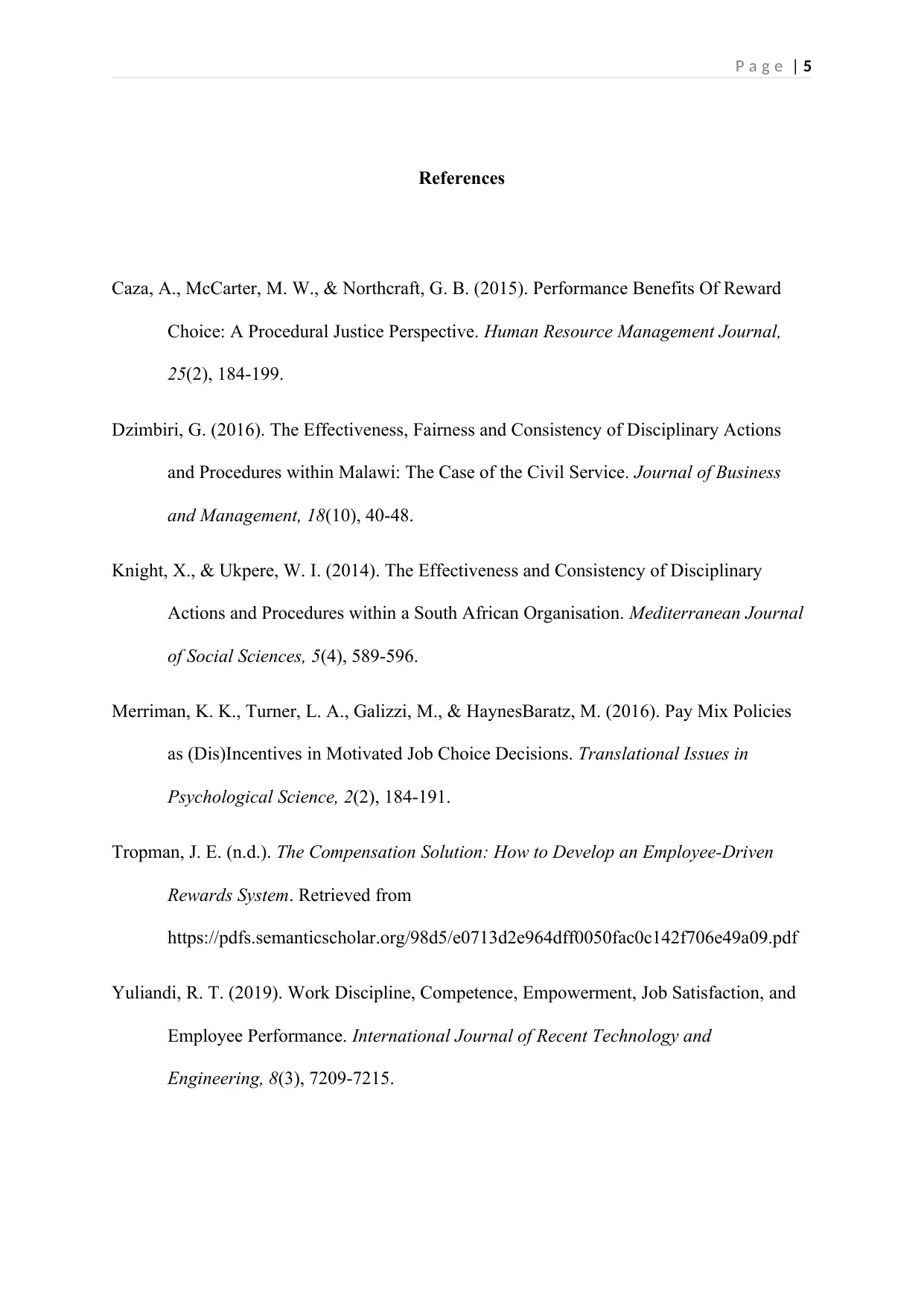
P a g e | 5
References
Caza, A., McCarter, M. W., & Northcraft, G. B. (2015). Performance Benefits Of Reward
Choice: A Procedural Justice Perspective. Human Resource Management Journal,
25(2), 184-199.
Dzimbiri, G. (2016). The Effectiveness, Fairness and Consistency of Disciplinary Actions
and Procedures within Malawi: The Case of the Civil Service. Journal of Business
and Management, 18(10), 40-48.
Knight, X., & Ukpere, W. I. (2014). The Effectiveness and Consistency of Disciplinary
Actions and Procedures within a South African Organisation. Mediterranean Journal
of Social Sciences, 5(4), 589-596.
Merriman, K. K., Turner, L. A., Galizzi, M., & HaynesBaratz, M. (2016). Pay Mix Policies
as (Dis)Incentives in Motivated Job Choice Decisions. Translational Issues in
Psychological Science, 2(2), 184-191.
Tropman, J. E. (n.d.). The Compensation Solution: How to Develop an Employee-Driven
Rewards System. Retrieved from
https://pdfs.semanticscholar.org/98d5/e0713d2e964dff0050fac0c142f706e49a09.pdf
Yuliandi, R. T. (2019). Work Discipline, Competence, Empowerment, Job Satisfaction, and
Employee Performance. International Journal of Recent Technology and
Engineering, 8(3), 7209-7215.
References
Caza, A., McCarter, M. W., & Northcraft, G. B. (2015). Performance Benefits Of Reward
Choice: A Procedural Justice Perspective. Human Resource Management Journal,
25(2), 184-199.
Dzimbiri, G. (2016). The Effectiveness, Fairness and Consistency of Disciplinary Actions
and Procedures within Malawi: The Case of the Civil Service. Journal of Business
and Management, 18(10), 40-48.
Knight, X., & Ukpere, W. I. (2014). The Effectiveness and Consistency of Disciplinary
Actions and Procedures within a South African Organisation. Mediterranean Journal
of Social Sciences, 5(4), 589-596.
Merriman, K. K., Turner, L. A., Galizzi, M., & HaynesBaratz, M. (2016). Pay Mix Policies
as (Dis)Incentives in Motivated Job Choice Decisions. Translational Issues in
Psychological Science, 2(2), 184-191.
Tropman, J. E. (n.d.). The Compensation Solution: How to Develop an Employee-Driven
Rewards System. Retrieved from
https://pdfs.semanticscholar.org/98d5/e0713d2e964dff0050fac0c142f706e49a09.pdf
Yuliandi, R. T. (2019). Work Discipline, Competence, Empowerment, Job Satisfaction, and
Employee Performance. International Journal of Recent Technology and
Engineering, 8(3), 7209-7215.
⊘ This is a preview!⊘
Do you want full access?
Subscribe today to unlock all pages.

Trusted by 1+ million students worldwide

P a g e | 6
1 out of 7
Related Documents
Your All-in-One AI-Powered Toolkit for Academic Success.
+13062052269
info@desklib.com
Available 24*7 on WhatsApp / Email
![[object Object]](/_next/static/media/star-bottom.7253800d.svg)
Unlock your academic potential
Copyright © 2020–2025 A2Z Services. All Rights Reserved. Developed and managed by ZUCOL.





